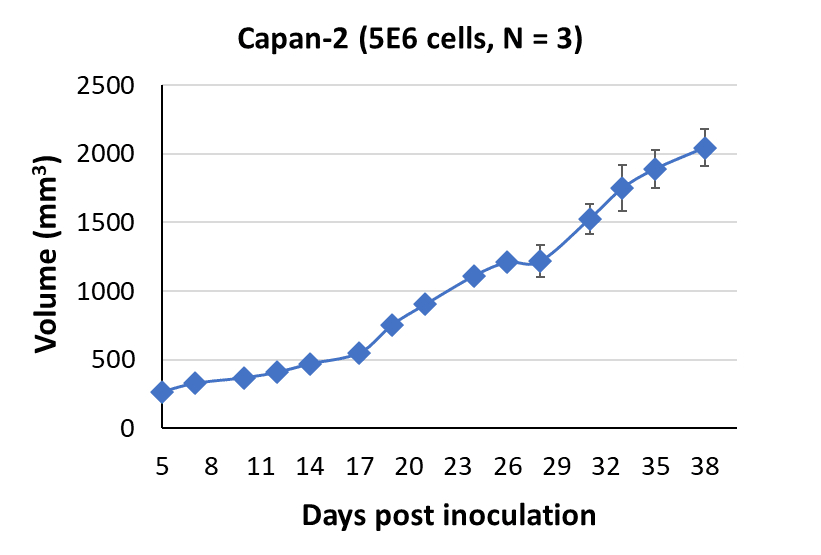About Capan-2
Capan-2 is a human pancreatic ductal adenocarcinoma cell line that was initially derived in 1975 from a primary tumor of a 56-year-old Caucasian male. These cells demonstrate an epithelial morphology and grow in adherent tissue culture. The Capan-2 cell line expresses a mutant form of the oncogene KRAS (G12V) and exhibits elevated levels of the epidermal growth factor receptor (EGFR).
Overexpression of both EGFR and KRAS additively upregulates PI3K. Notably, Capan-2 cells express wildtype p53 and normal levels of SMAD4. SMAD4 is phosphorylated by ERK/MAPK and can then interact with glycogen synthase kinase 3 (GSK3) to contribute to protein stability via downstream phosphorylation. The presence of essential tumor suppressor components in a consistently tumorigenic cell line suggests the involvement of alternate tumor growth mechanisms.
Capan-2 Tumor Kinetics in the SRG™ Rat

Capan-2 cells have been extensively studied in xenograft models and have demonstrated resistance to drug therapies such as vorinostat (histone deacetylase inhibitor), cisplatin (structural deformation of DNA), and gemcitabine (DNA polymerase inhibitor). In SRG rats, Capan-2 tumors exhibit fluid-filled, hollow, and necrotic characteristics.
Products & Services
Xenograft Efficacy Studies
Includes collection of blood, tissues & tumor for ADME, PK/PD and analysis.
(Bi)weekly Tumor Sampling
Via fine needle aspiration (FNA). For longitudinal evaluation of drug exposure, histology and gene expression.
OncoRats
Cutting edge models optimized for engraftment.
Get help with your research by scheduling a call with Hera.
References (MLA):
- Demagny, Hadrien, and Edward De Robertis. “Point Mutations in the Tumor Suppressor Smad4/DPC4 Enhance Its Phosphorylation by GSK3 and Reversibly Inactivate TGF-β Signaling.” Taylor & Francis Online, 18 Nov. 2015, tandfonline.com/doi/full/10.1080/23723556.2015.1025181.
- Fong, Jason T., et al. “Alternative Signaling Pathways as Potential Therapeutic Targets for Overcoming EGFR and C-MET Inhibitor Resistance in Non-Small Cell Lung Cancer.” PLOS ONE, 4 Nov. 2013, journals.plos.org/plosone/article?id=10.1371%2Fjournal.pone.0078398.
- Shi, Yan, et al. “Human SMAD4 Is Phosphorylated at Thr9 and Ser138 by Interacting with NLK.” SpringerLink, 19 Aug. 2009, link.springer.com/article/10.1007/s11010-009-0230-2.
- Wang, Li, et al. “Glycogen Synthesis and beyond, a Comprehensive Review of GSK3 as a Key Regulator of Metabolic Pathways and a Therapeutic Target for Treating Metabolic Diseases.” Wiley Online Library, 3 Nov. 2021, onlinelibrary.wiley.com/doi/10.1002/med.21867.
